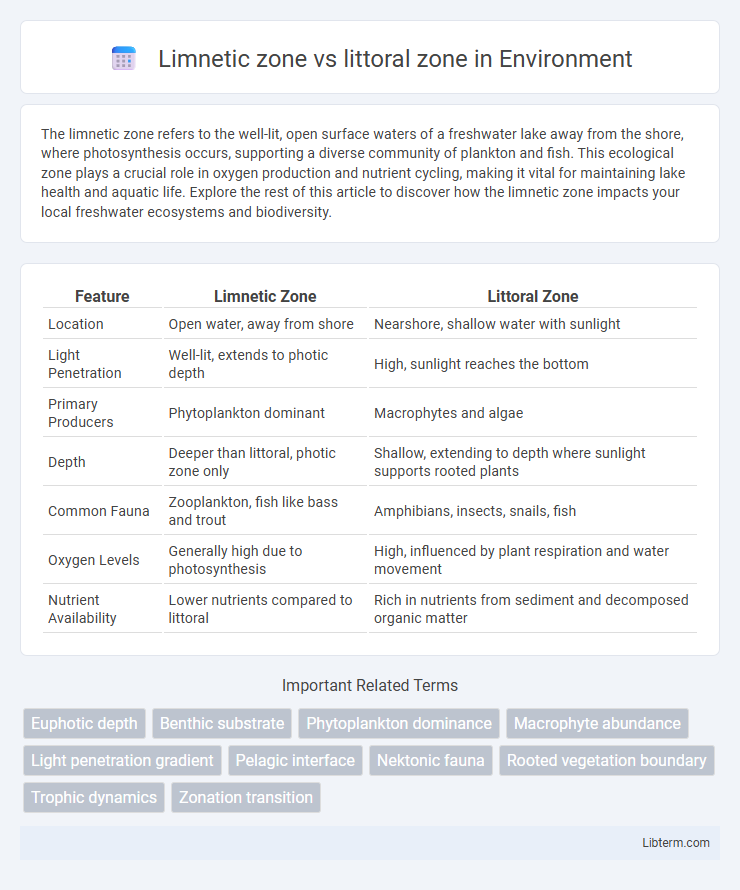The limnetic zone refers to the well-lit, open surface waters of a freshwater lake away from the shore, where photosynthesis occurs, supporting a diverse community of plankton and fish. This ecological zone plays a crucial role in oxygen production and nutrient cycling, making it vital for maintaining lake health and aquatic life. Explore the rest of this article to discover how the limnetic zone impacts your local freshwater ecosystems and biodiversity.
Table of Comparison
| Feature | Limnetic Zone | Littoral Zone |
|---|---|---|
| Location | Open water, away from shore | Nearshore, shallow water with sunlight |
| Light Penetration | Well-lit, extends to photic depth | High, sunlight reaches the bottom |
| Primary Producers | Phytoplankton dominant | Macrophytes and algae |
| Depth | Deeper than littoral, photic zone only | Shallow, extending to depth where sunlight supports rooted plants |
| Common Fauna | Zooplankton, fish like bass and trout | Amphibians, insects, snails, fish |
| Oxygen Levels | Generally high due to photosynthesis | High, influenced by plant respiration and water movement |
| Nutrient Availability | Lower nutrients compared to littoral | Rich in nutrients from sediment and decomposed organic matter |
Introduction to Aquatic Zones
The limnetic zone refers to the open, well-lit surface waters of a lake away from the shore, where photosynthesis primarily occurs by phytoplankton. The littoral zone is the nearshore area of a lake or pond, characterized by abundant light penetration allowing growth of rooted aquatic plants and providing critical habitat for diverse organisms. Both zones are essential in aquatic ecosystems for supporting distinct biological communities and maintaining ecological balance.
Defining the Limnetic Zone
The limnetic zone refers to the open, well-lit surface waters away from the shore in a freshwater lake, where photosynthesis primarily occurs due to abundant sunlight penetration. This zone supports a diverse array of phytoplankton and zooplankton, serving as a crucial habitat for many fish species. Unlike the littoral zone, which encompasses the nearshore area with rooted aquatic plants, the limnetic zone lacks vegetation on the lakebed and is deeper, making it a key area for primary production in lake ecosystems.
Overview of the Littoral Zone
The littoral zone is the nearshore area of a lake or pond where sunlight penetrates to the sediment, allowing rooted aquatic plants to thrive. This zone supports high biodiversity, including various species of fish, invertebrates, and algae, due to the abundance of nutrients and vegetation. Its ecological importance lies in providing habitat, food sources, and breeding grounds for many freshwater organisms.
Physical Characteristics Comparison
The limnetic zone, characterized by open, well-lit surface waters away from the shore, contrasts with the littoral zone's shallow area near the shoreline with abundant sunlight penetration supporting rooted vegetation. Temperature in the limnetic zone remains more stable and cooler compared to the littoral zone, where sunlight heats the water more rapidly, causing greater thermal variability. Substrate composition differs as well; the littoral zone often features diverse sediments and rocky bottoms while the limnetic zone primarily consists of deeper, open water with minimal physical structures.
Light Penetration and Photosynthesis
The littoral zone receives the highest light penetration, supporting abundant photosynthesis due to shallow waters and abundant sunlight, fostering diverse aquatic plants and algae. In contrast, the limnetic zone, although well-lit, experiences reduced light intensity as depth increases, limiting photosynthesis primarily to phytoplankton and floating vegetation. Light attenuation directly influences oxygen production and primary productivity, distinguishing the ecological roles of each zone.
Biodiversity in Limnetic vs Littoral Zones
The littoral zone, characterized by shallow waters near the shore with abundant sunlight, supports high biodiversity due to diverse aquatic plants, algae, and numerous invertebrates and fish species relying on complex habitats. In contrast, the limnetic zone, consisting of open water away from the shore, exhibits lower biodiversity but sustains abundant phytoplankton and zooplankton populations, which form the base of the aquatic food web. The structural complexity of the littoral zone creates niches for various organisms, while the limnetic zone primarily supports species adapted to pelagic environments.
Common Plant Species in Each Zone
The limnetic zone, characterized by open, well-lit waters, predominantly features phytoplankton such as diatoms and green algae, which serve as primary producers in aquatic food webs. In contrast, the littoral zone, found near shorelines with ample sunlight and shallow depths, harbors rooted aquatic plants like cattails (Typha), water lilies (Nymphaeaceae), and bulrushes (Schoenoplectus). These littoral plants provide essential habitats and oxygenate the water, supporting diverse aquatic organisms and contributing to ecosystem stability.
Typical Animal Inhabitants
The limnetic zone primarily hosts planktonic organisms such as zooplankton and phytoplankton, alongside fish species like bass and trout that thrive in open, well-lit waters. In contrast, the littoral zone supports a diverse array of animals including amphibians, snails, insects, and small fish that depend on submerged vegetation and shallow waters for shelter and feeding. These zones differ significantly in habitat structure, influencing the specific animal communities adapted to each environment.
Ecological Roles and Interactions
The limnetic zone, characterized by open water away from the shore, supports primary producers like phytoplankton that form the base of the aquatic food web, sustaining zooplankton and various fish species. The littoral zone, extending from the shore to the depth where sunlight penetrates the sediment, provides critical habitat for diverse aquatic plants, invertebrates, and breeding grounds for amphibians and fish, promoting high biodiversity. Interactions between these zones include nutrient cycling and energy flow, with organisms in the littoral zone contributing organic matter that fuels limnetic productivity.
Human Impacts on Limnetic and Littoral Zones
Human activities such as agriculture runoff and urban development increase nutrient loading in limnetic and littoral zones, leading to eutrophication and harmful algal blooms. Shoreline construction and habitat destruction disrupt the littoral zone's vital plant and animal communities, reducing biodiversity and altering ecosystem functions. Pollution and sedimentation also impair water quality in both zones, impacting fisheries and recreational use critical to local economies.
Limnetic zone Infographic

 libterm.com
libterm.com